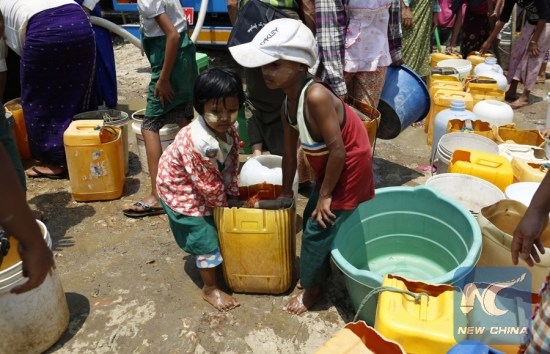
A girl and a boy carry water with a bucket after collecting the water from donors at Dala Township on the outskirts of Yangon, Myanmar, April 28, 2016. (Xinhua/U Aung)
El Nino is over but its impact on children is set to worsen as disease, malnutrition continue to spread, and in Eastern and Southern Africa alone, 26.5 million children are in need of aid, the UN Children's Fund (UNICEF) said Friday.
The 2015-2016 El Nino has ended but its devastating impact on children is worsening, as hunger, malnutrition and disease continue to increase following the severe droughts and floods spawned by the event, one of the strongest on record, UNICEF said.
And there is a strong chance La Nina -- El Nino's flip side -- could strike at some stage this year, further exacerbating a severe humanitarian crisis that is affecting millions of children in some of the most vulnerable communities, UNICEF said in a report called "It's not over -- El Nino's impact on children."
Children in the worst affected areas are going hungry. In Eastern and Southern Africa -- the worst hit regions -- some 26.5 million children need support, including more than one million who need treatment for severe acute malnutrition.
In many countries, already strained resources, have reached their limits, and affected families have exhausted their coping mechanisms -- such as selling off assets and skipping meals. Unless more aid is forthcoming, including urgent nutritional support for young children, decades of development progress could be eroded.
Meanwhile, El Nino affected access to safe water in many countries, and has been linked to increases in diseases such as dengue fever, diarrhoea and cholera, which are major killers of children.
In South America, and particularly Brazil, El Nino has created favourable breeding conditions for the mosquito that can transmit Zika, dengue, yellow fever and chikungunya.
If La Nina does develop, it could contribute to the spread of the Zika virus to areas that have not been affected to date.
As of mid-2016, a widespread epidemic of Zika fever, caused by the Zika virus, is ongoing in the Americas and the Pacific. The outbreak began in early 2015 in Brazil, then spread to other parts of South and North America. It is also affecting several islands in the Pacific.
In the new report, UNICEF said that there are serious concerns that Southern Africa, the global epicentre of the AIDS pandemic, could see an increased transmission of HIV as a result of El Nino's impact.
Lack of food affects access to anti-retroviral therapy (ART), as patients tend not to take treatment on an empty stomach, and many people will use their limited resources for food rather than transport to a health facility.
Drought can also force adolescent girls and women to engage in transactional sex to survive. And, mortality for children living with HIV is two to six times higher for those who are severely malnourished than for those who are not.
"Millions of children and their communities need support in order to survive. They need help to prepare for the eventuality La Nina will exacerbate the humanitarian crisis. And they need help to step up disaster risk reduction and adaptation to climate change, which is causing more intense and more frequent extreme weather events," said UNICEF's director of emergency programs, Afshan Khan.
"The same children who are affected by El Nino and threatened by La Nina, find themselves on the frontlines of climate change," Khan said.
On May 20, UN Secretary-General Ban Ki-moon announced the appointments of Mary Robinson of Ireland and Macharia Kamau of Kenya as his special envoys on El Nino and Climate.
"These appointments come at a time of great urgency," Ban's spokesman Stephane Dujarric told reporters here. "Drought and flooding associated with El Nino have created massive needs across the world, especially in the four worst affected regions of East Africa, Southern Africa, Central America and the Pacific."
This year's El Nino is taking place in a world already dramatically affected by climate change. More extreme weather events are expected in the future, and these hit the poorest communities -- those least responsible for climate change -- first and hardest. Aid is not enough; a longer term approach is required in order to build the resilience of the most vulnerable.


















































